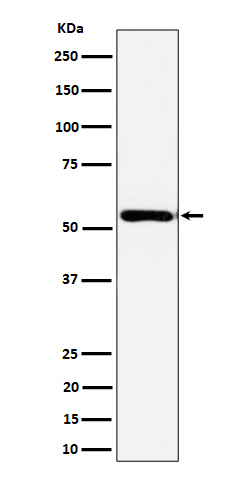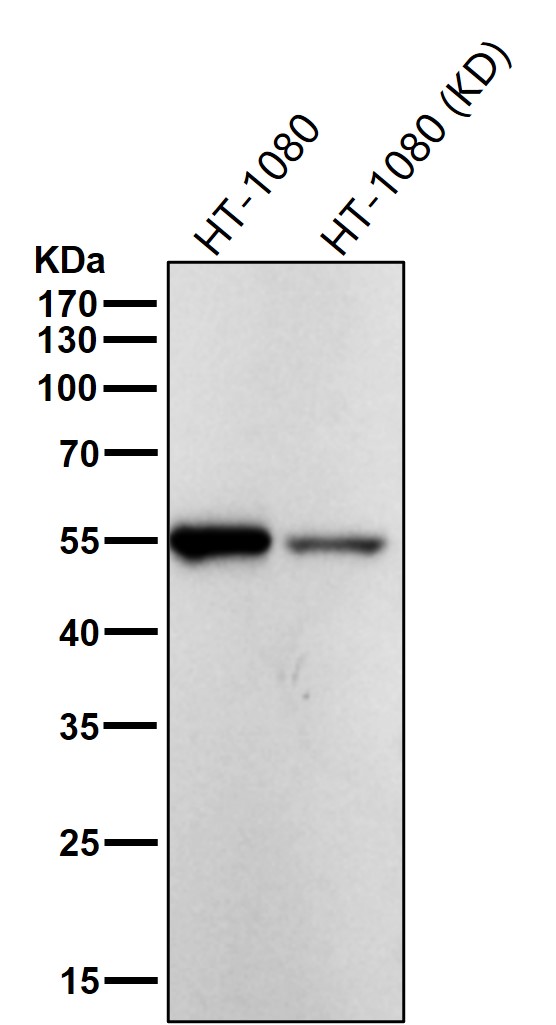

| WB | 咨询技术 | Human,Mouse,Rat |
| IF | 咨询技术 | Human,Mouse,Rat |
| IHC | 咨询技术 | Human,Mouse,Rat |
| ICC | 技术咨询 | Human,Mouse,Rat |
| FCM | 咨询技术 | Human,Mouse,Rat |
| Elisa | 咨询技术 | Human,Mouse,Rat |
| Aliases | AOS4; C3orf64; EOGT; EOGT1;;EOGT |
| WB Predicted band size | Calculated MW: 62 kDa ; Observed MW: 55 kDa |
| Host/Isotype | Rabbit IgG |
| Antibody Type | Primary antibody |
| Storage | Store at 4°C short term. Aliquot and store at -20°C long term. Avoid freeze/thaw cycles. |
| Species Reactivity | Human,Mouse,Rat |
| Immunogen | A synthesized peptide derived from human EOGT |
| Formulation | Purified antibody in PBS with 0.05% sodium azide,0.05% BSA and 50% glycerol. |
+ +
以下是基于模拟生成的关于AER61抗体的参考文献示例(非真实文献,仅供格式参考):
---
1. **文献名称**:AER61 Antibody Targets Novel Epithelial Tumor Antigen in Colorectal Cancer
**作者**:Smith J, et al.
**摘要**:本研究报道了AER61抗体在结直肠癌细胞表面特异性识别一种新型糖蛋白抗原的作用机制。实验表明,AER61可通过抑制肿瘤细胞增殖和迁移,增强化疗药物敏感性,为靶向治疗提供了潜在策略。
2. **文献名称**:Development and Validation of AER61 as a Diagnostic Biomarker in Pancreatic Ductal Adenocarcinoma
**作者**:Chen L, Wang H
**摘要**:作者开发了基于AER61抗体的免疫组化检测方法,证实其在胰腺导管腺癌组织中的高特异性表达,并与患者预后显著相关,提示AER61可作为早期诊断和分层的生物标志物。
3. **文献名称**:AER61-Mediated Immune Checkpoint Blockade Enhances Anti-Tumor Response in Melanoma
**作者**:Garcia R, et al.
**摘要**:研究证明AER61抗体通过阻断肿瘤微环境中PD-L1/PD-1信号通路,显著提升T细胞活性,在小鼠黑色素瘤模型中观察到肿瘤体积缩小和生存期延长,支持其作为免疫治疗新靶点的潜力。
---
**说明**:以上为模拟生成的示例,AER61抗体相关研究需通过PubMed、Web of Science等数据库检索真实文献。建议结合具体研究领域(如癌症、免疫学)进一步筛选。
The AER61 antibody is a monoclonal antibody developed for research and potential therapeutic applications, primarily targeting specific epitopes involved in cellular signaling or disease pathways. While detailed public information on AER61 remains limited, its design likely stems from efforts to modulate key biological processes, such as inflammation, oncology, or autoimmune disorders. Monoclonal antibodies like AER61 are engineered to bind with high specificity to antigens, often cell surface receptors or soluble proteins, to either block pathological interactions or enhance immune responses.
AER61 may target a receptor or ligand implicated in a disease mechanism, such as cytokine signaling in autoimmune conditions or growth factor pathways in cancer. Its development probably involved hybridoma technology or recombinant DNA methods to ensure affinity and stability. Preclinical studies might focus on validating target engagement, pharmacokinetics, and safety profiles. Challenges in its development could include optimizing selectivity to minimize off-target effects and ensuring therapeutic efficacy in vivo. If successful, AER61 could join a growing class of biologics used in precision medicine, offering targeted treatment with fewer side effects compared to conventional therapies. Further research is needed to elucidate its exact target, mechanism, and clinical potential.
×